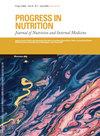Serum zinc level in Iron Deficiency and Iron Deficiency Anemia of children aged 6 months to 5 years
4区 医学
Q4 Agricultural and Biological Sciences
引用次数: 3
Abstract
Background: Iron Deficiency Anemia (IDA) is the most common anemia in all age groups. The coexistence of iron deficiency anemia and zinc (Zn) deficiency is quite common, for most of the etiologic factors are common. The purpose of this study is to determine the prevalence of zinc deficiency in children with iron deficiency and/or iron deficiency anemia. Method: One hundred and sixty child patients within 6month-5 year age range diagnosed with iron deficiency and/or iron deficiency anemia and 91 children with no iron deficiency and/or iron deficiency anemia diagnosis were included in the study. The relationships between serum zinc levels and other biochemical and hematological parameters were examined. Results: It was observed that the study and control groups had similar demographic characteristics, and there was no statistically significant difference between two groups in terms of average age (months), distribution of age groups, and gender groups. Statistically significant differences were observed between hemoglobin (Hb), haematocrit (Hct), mean corpuscular volume (MCV), red cell distributionwidth (RDW), iron (Fe), total iron binding capacity (TIBC), transferrin saturation (TS) and Ferritin values of the study group and control group, and the cases in the study group were determined to be highly anemic. Statistically significant difference was determined between groups in terms of zinc levels, and zinc levels in the study group were determined to be lower than those in the control group. Zinc deficiency (10%) in children diagnosed with iron deficiency and/or iron deficiency anemia was found more common compared to the control group (2.2%). A positive correlation between serum zinc levels and Hb, Hct, MCV, Fe, TS and Ferritin, and a negative correlation between serum zinc levels and RDW and total TIBC were detected in the study group. Conclusion: According to these results, it was concluded that children with iron deficiency could simultaneously have zinc deficiency, the iron-zinc combination might be more effective for the treatment of iron deficiency than treatment with only iron, and early age supplementation programs might be useful for the highrisk groups such as childhood until zinc deficiency tests gave routine results.6个月至5岁儿童缺铁和缺铁性贫血的血清锌水平
背景:缺铁性贫血(IDA)是所有年龄组中最常见的贫血。缺铁性贫血和锌缺乏症并存是很常见的,因为大多数病因都是常见的。本研究的目的是确定缺铁和/或缺铁性贫血儿童缺锌的患病率。方法:将160名6个月-5岁范围内被诊断为缺铁和/或缺铁性贫血的儿童患者和91名未被诊断为铁缺乏和/或铁缺乏性贫血症的儿童纳入研究。检测血清锌水平与其他生化和血液学参数之间的关系。结果:观察到,研究组和对照组具有相似的人口统计学特征,两组在平均年龄(月)、年龄组分布和性别组方面没有统计学上的显著差异。研究组和对照组的血红蛋白(Hb)、血细胞比容(Hct)、平均红细胞体积(MCV)、红细胞分布宽度(RDW)、铁(Fe)、总铁结合能力(TIBC)、转铁蛋白饱和度(TS)和铁蛋白值之间存在统计学上的显著差异,研究组的病例被确定为高度贫血。在锌水平方面,各组之间存在统计学显著差异,研究组的锌水平低于对照组。与对照组(2.2%)相比,被诊断为缺铁和/或缺铁性贫血的儿童锌缺乏(10%)更为常见。研究组的血清锌水平与Hb、Hct、MCV、Fe、TS和Ferritin呈正相关,血清锌水平和RDW和总TIBC呈负相关。结论:根据这些结果,可以得出结论,缺铁儿童可能同时患有锌缺乏症,铁锌联合治疗缺铁可能比仅用铁治疗更有效,早期补充计划可能对儿童等高危人群有用,直到锌缺乏测试得出常规结果。
本文章由计算机程序翻译,如有差异,请以英文原文为准。
求助全文
约1分钟内获得全文
求助全文
来源期刊

Progress in Nutrition
医学-营养学
CiteScore
1.40
自引率
0.00%
发文量
0
审稿时长
>12 weeks
期刊介绍:
Progress in Nutrition was founded in 1999 as an independent magazine, a multidisciplinary approach, dedicated to issues of nutrition and metabolism.
 求助内容:
求助内容: 应助结果提醒方式:
应助结果提醒方式:


